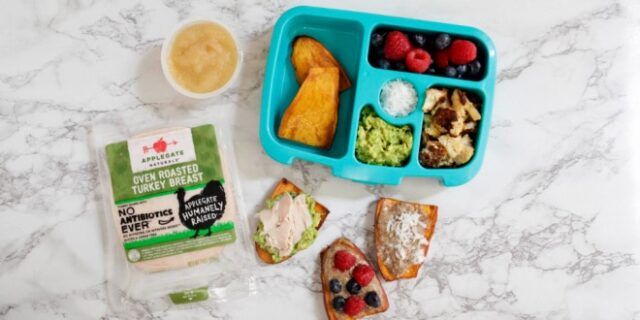
Original post by Robin Strathdee; updated by Chelsea Long.
In part 1, we shared a few strategies for dealing with other people’s food–what your kids eat when they’re away from home. Today, let’s talk about some situations you’re likely to encounter other people’s food and how to apply your plan in real life.
The list of adults who are likely to be offering your kids food is long and varied: grandparents and other family members, teachers and other adults at school or daycare, coaches and team parents, bank tellers, grocery store greeters…yeah, there are some people on that list you probably didn’t think of, right? Your strategy will play out differently based on who you’re interacting with, so let’s talk about some common scenarios and how to apply your chosen plan when it comes to other people’s food.
Family Members
We often hear from parents who are trying to feed their kids a certain way that they feel sabotaged by members of their own families who just don’t seem willing to follow the guidelines they’ve put in place. Mom and Dad ask for no gluten and dairy, but pick the kids up to find the remnants of soft-serve cones on their little ones’ faces. Depending on the family dynamic, a conversation may or may not ensue, Mom and Dad are bursting with frustration.
It’s important to remember that many times our family members try to show our children love through food. They want to give your kids what they know will make them happy, and they probably don’t quite understand the restrictions you’ve put in place.
Put your plan to the test…
If your plan is to “let it ride”…
There’s really nothing to be done here. You sent the kids with Grandma and the only rule you set was, “Have fun!” You’re golden.
If your plan is to “keep it between the lines”…
You have to have a serious conversation longer than the 30 seconds while you’re loading them into the car. Sit down with any family members who will be responsible for feeding your kids and explain to them what your boundaries are around other people’s food and why. Use real life examples to illustrate why you feel the boundaries you set are so important: “Remember that time that Katie broke out in a rash on her stomach and back? We’ve narrowed that down to eating dairy.”
Be very clear about what is and isn’t okay, and give them examples they’ll be familiar with. Show them some labels and let them know if there are any sneaky ingredients they should watch for. Let them know that they can contact you for final approval if there’s a question. Be prepared that they won’t get it right every time. There’s a learning curve, and if you’ve ever completed a Whole30 you know that the curve can be steep. Stick to your guns and help them see where things went wrong, but be patient.
If you’re taking the “my way or the highway” approach …
Be prepared to do a lot of explaining. If you’re going to prohibit anything you don’t prepare or expressly approve, you’re going to get a lot of questions from your family. In some cases, your family members will be familiar with the circumstances that have brought you to this point, which can help.
Again, be incredibly clear about what is and isn’t okay since in these situations there’s less room for error (especially when dealing with true allergies). If no OPF is acceptable, don’t be afraid to voice that! This approach is not for the meek–it’s going to require a lot of interaction on your child’s behalf.
If you’re going to be solely responsible for your child’s food, make sure you’re willing (and able) to prepare and send enough. One of the hardest things for a Grandma is having a hungry kiddo and nothing to give them. If the food you sent them with is supposed to last three meals, leave instructions to that effect–don’t leave your family members guessing about what and how much they can have when.
If you encounter a family member who refuses to respect your boundaries…
Times like this require more of a practical approach. First, if you’re co-parenting, make sure your partner is on board with your plan. This will never work if one of you is willing to bend the rules with family. Next, work together to outline a logical progression of “next steps.” If Grandpa won’t stop giving Timmy crackers, what are we going to do first? If he still doesn’t stop, then what? How far are we willing to take this boundary around other people’s food?
Once you have answered those questions in a manner you’re comfortable with, it’s time to talk to the family members in question. Sit them down and explain (again) why you’ve set the boundaries, and what the next step will be. Chances are, once you let them know how committed you are to following these guidelines, they’ll follow along. Most family members aren’t willing to sacrifice relationships over something silly like crackers.
Schools and Daycares
Navigating the food word of daycares, public schools, and even private schools can be dizzying and daunting. There are federal, state and even district laws governing what foods can and can’t be served, there are school policies concerning allergens, class parties and surprise birthday treats. The amount of food presented to your kiddos on a daily basis is overwhelming. That’s why it’s really important to have your family’s plan about other people’s food firmly in place when you’re dealing with educational institutions.
Put your plan to the test…
If your plan is to “let it ride” …
Again, there’s not much for you to do here. Plan breakfasts and dinners that you know will set them up for success throughout their day, give your kids the option of packing a Good Food lunch, but don’t stress if they opt for the pizza sticks instead.
If your plan is to “keep it between the lines” …
This is going to require some conversation. Make an appointment to talk to your child’s teacher, and if necessary the principal or daycare director. Let them know what your boundaries are and, most importantly, explain why you have those boundaries.
Ask if there are any steps you need to take. They may ask you to provide your kiddos snacks, pack their lunch, or send alternative treats for celebrations. Offer to help organize class parties and make them friendly to your kiddo and the others with dietary restrictions. They also may ask you to get a doctor’s note. Don’t be intimidated by that! We’ll talk about how to handle that later on.
Find out what accommodations can be made. For example, our public school offered Rice Chex cereal so my munchkin would have a gluten-free option. My youngest’s preschool teacher asked for a list of snack ideas and offered to let us know when there’s a birthday coming up so we can bring her alternative treats.
If you’re taking the “my way or the highway” approach …
Plan to have some lengthy conversations with school administration, in the same way that you did with your family members. Give them details and prepare to answer questions. You’re likely going to need a doctor’s note for this strategy.
Packing lunches, snacks, and birthday treats is a must. If your kiddo can’t have any food from the school or other parents, then you’ve got to make doubly sure their eats are covered. Since there’s no room for error in this plan, send some emergency food, too, in case your kiddo winds up in a surprise situation. Luckily there are so many shelf-stable options available now. Shop some of our favorites at Thrive Market.
If you find you need a doctor’s note…
Don’t be intimidated by the idea of talking to your doctor about your kids’ diet. Your doctor is only interested in keeping your family healthy. Here’s how I suggest getting the support you need for your kiddo:
- Make an appointment, rather than showing up unannounced with a form. Plan to have the same kind of conversation with the doctor as you had with your family and the school administration.
- Give the doctor examples of how these foods affect your kids and how changing their diet has relieved some health issues.
- Try to think ahead and prepare yourself to answer questions your doctor might have. Bring information to reinforce your perspective and demonstrate that your kids won’t be missing anything nutritionally by removing certain food groups. You can even bring a copy of It Starts With Food with you.
- Fill out any necessary forms in advance. Detail what foods you’d like to avoid and what symptoms they cause. Then, all your doctor has to do is sign when they’re ready.
If your doctor says no, you still have a couple of options. First, you can go back to the school and see how willing they are to work with you without the official paperwork. Hopefully you can work out a plan with the folks who will be dealing with your kids directly. Secondly, you can find another doctor. If you feel like this gives you significant cause to look for care elsewhere, take the opportunity to find a provider who has a viewpoint that will support yours.
Play Dates, Sporting Events, and Other Occasions
These may be less frequent, but food-related issues still arise. There are post-practice snacks, post-win celebrations, sleep-overs, and impromptu play dates. Compared to some of the situations we’ve already mentioned, applying your strategy here should be pretty simple.
Put your plan to the test…
If your plan is to let it ride …
Well, there’s really nothing for you to do here, either. Take those situations as they come.
If you’re planning to use the ‘keep it between the lines’, or the ‘my way or the highway’, approach …
A simple conversation and a promise to send alternative snacks should cut it here. These folks aren’t likely to be invested enough in what your kids are eating to cause too much of a fuss.
If you’re dealing with something like a sleepover with full meals, call the other parent and explain the situation. Ask what’s on the menu and offer to provide an alternative if necessary. Plan to pack enough of the alternative snacks for everyone at the get-together, to reduce any awkwardness around other people’s food.
You can do this!
There’s no way to cover every possible situation involving other people’s food. The goal is to present you with the tools you need for form and apply a strategy that keeps your kids (and in the process, you) happy and healthy while at the same time navigating the social-food world. There will always be situations that don’t go according to plan, but with confidence and planning, there’s no challenge that you can’t face.
Originally posted October 2013 by Robin Strathdee.
Updated November 2018.
You Might Also Like…
















